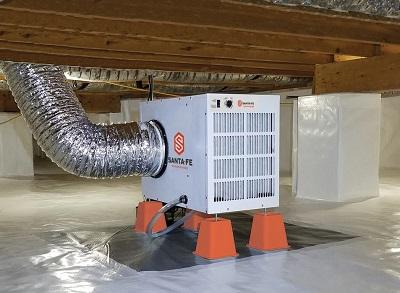
The crawl space is one of the most confusing and misunderstood areas of a home. If not treated properly, a crawl space can be detrimental to the following:
- Structure of the home
- Health and comfort of the homeowners
- Home's energy consumption
Crawl spaces are part of the home, even if it is out of sight or mind. It is also most likely the dirtiest, dampest, and smelliest space in the entire house. It is plagued by high levels of moisture leading to mold, insect infestations, structural issues, and poor indoor air quality throughout the whole home.
In many parts of the country, during the spring, summer, and fall months, warm, moist air enters the vented crawl space from the outside and condenses on the cooler surfaces of the walls, floor, and ductwork. This, coupled with the moisture from the dirt ground and water leaking through imperfections in the foundation walls, has led to an epidemic of sick houses.
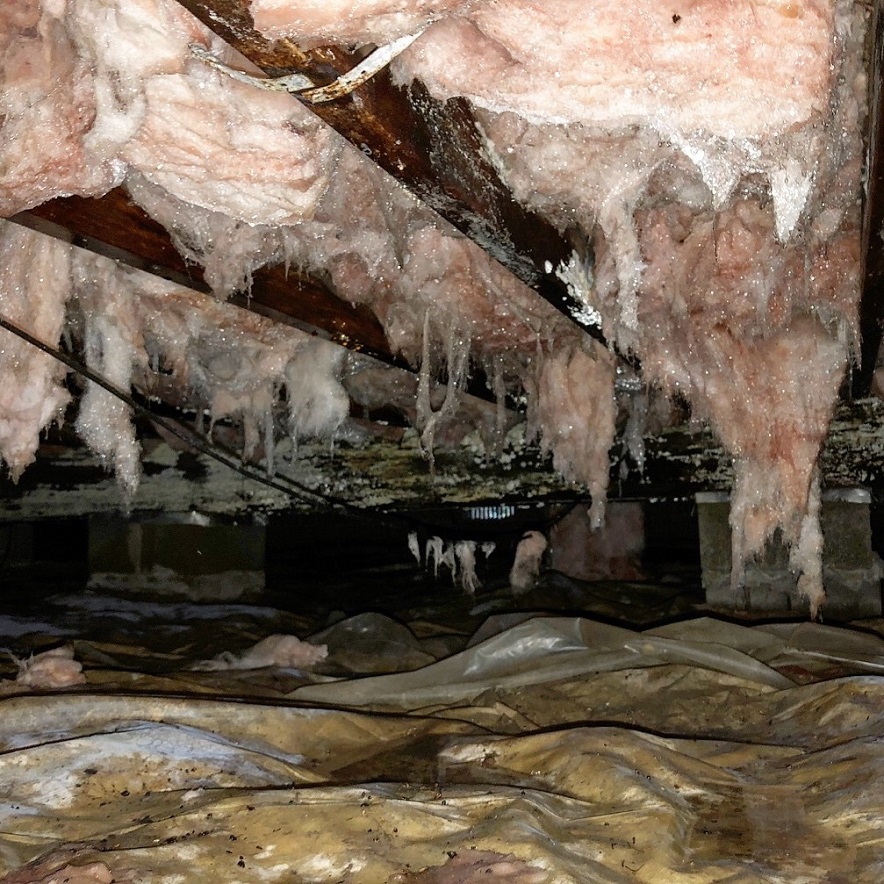
Photo Credit – Matt Hargrove, Owner Total Home Performance
This excess moisture contributes to wood rot, mold growth, poor air quality, and increased pest activity, including infestation and colonization. Moisture in crawl spaces often migrates to the home's upper levels through a "stack effect." In essence, whatever air is below the house is also inside the house. As warm air rises and escapes through the home's upper levels, new air finds its way into the home to replace what's been lost. Intake air comes in at the lower levels — through unsealed crawl spaces. As a result, moisture levels can quickly elevate in the crawlspace.
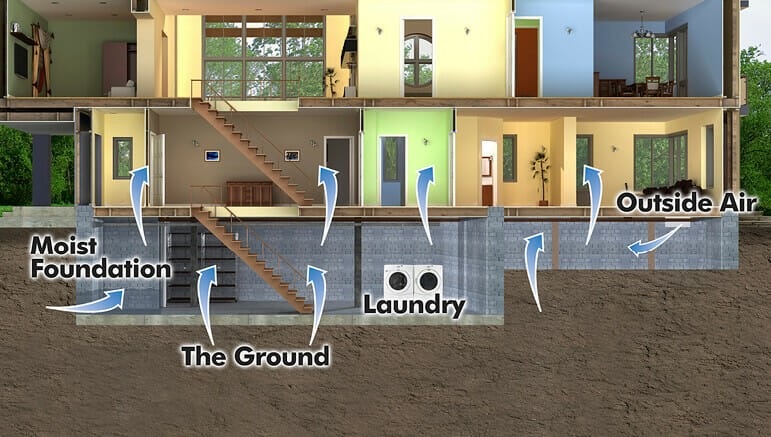
Once above 60% relative humidity, the crawl space will attract more pests, and grow mold, mildew, bacteria, and other biological allergens, leading to musty odors and even foundation structural issues. It is important to remember that polluted air in the crawlspace will make its way into the rest of the home, often carrying odors, contributing to poor indoor air quality and causing uncomfortably high humidity levels. Studies show that as much as 50 percent of the air in a home comes from these below-grade areas.
Below is a list of some of the biological contaminants that can exist in crawl spaces:
- → Fungi
- → Bacteria
- → Actinomycetes
- → Mycobacteria
- → Mold
- → Spores
- → Mycotoxins
- → Endotoxins
- → Inflammagens
- → Beta Glucans
- → Hemolysins
- → Microbial Volatile Organic Compounds (mVOCs)
Why Encapsulate Crawl Spaces?
A home with a vented crawl space is limited in its ability to separate the indoor living space from the outdoor environment because it is open to the outdoors. Homes with vented crawl spaces do not control airflow or vapor flow; instead, they depend on it. Open airflow and vapor flow create problems with mold, odor, elevated moisture, insects, and excessive energy consumption.
Building experts agree that in green grass climates, builders and homeowners should invest the additional effort to incorporate encapsulated space systems in both new and existing homes. The expense of moisture repairs and the increase in complaints and legal action related to mold growth in homes have made homeowners, builders, and architects much more aware of the need to control moisture in homes. This awareness is helping to drive demand to invest the additional effort to incorporate encapsulated space systems in both new and existing homes. The moisture control provided by a properly encapsulated space can dramatically reduce the risk and associated liability of mold and moisture damage.
According to Advanced Energy - The key components of a closed crawl space system work in tandem to control the variety of water sources that affect crawl spaces:
- Exterior water management prevents intrusion of liquid water
- Air sealed walls minimize the entry of humid outside air
- Vapor retarders minimize the evaporation of water from the ground or perimeter wall
- Mechanical drying systems provide ongoing, active removal of water vapor
- Drains or pumps remove water coming from plumbing leaks or floods
Once the crawl space is properly closed/encapsulated, the next step is implementing a "conditioning" or “mechanical drying strategy that is required by building code.
According to the 2021 International Residential Code addressing Foundations, the following are the options for "conditioning" an unvented crawl space:
- R408.3 Unvented crawl space.
2.1. Continuously operated mechanical exhaust ventilation at a rate equal to 1 cubic foot per minute (0.47 L/s) for each 50 square feet (4.7m) of crawl space floor area, including an air pathway to the common area (such as a duct or transfer grille), and perimeter walls insulated in accordance with Section N1102.2.10.1 of this code. - 2.2. Conditioned air supply sized to deliver at a rate equal to 1 cubic foot per minute (0.47 L/s) for each 50 square feet (4.7 m2) of under-floor area, including a return air pathway to the common area (such as a duct or transfer grille), and perimeter walls insulated in accordance with Section N1102.2.10.1 of this code.
- 2.3. Plenum in existing structures complying with Section M1601.5, if under-floor space is used as a plenum.
- 2.4. Dehumidification sized in accordance with manufacturer's specifications.
The challenge with all of these options, except for installing a dehumidifier, is that they offer no accurate control of moisture in the crawl space, which is really the only "conditioning" needed in the space. Only a dehumidifier provides the ability to set the conditions to a specific RH. In addition to controlling the RH, this solution enables the crawl space to be as isolated as possible from the rest of the house. Why is this important? If you ever read through the list of chemicals in termite treatment – you would think the same thing. Here is a link to a study on how pesticides can affect your health - Indoor risks of pesticide uses are significantly linked to hazards of the family members.
Health & Comfort
High humidity in homes has been scientifically documented to cause health-related issues. Mold, bacteria, cockroaches, and dust mites have been linked to triggering allergies and asthma attacks and may even cause children who do not have allergies or asthma to develop either condition. Exposure can cause coughing, sneezing, wheezing, upper respiratory irritation, and asthma symptoms.
Effects of Moisture on the House
Excess moisture in the crawl space can cause mold to grow. Mold can grow in or on almost anything in the home, including furniture, carpet, wood, drywall, and insulation. Too much moisture can also cause wood to buckle, split and even rot, which may weaken the structure of the home. It can even cause peeling, chipping, or cracking of paint.
Signs of excess moisture in the home that may be coming from the crawl space:
- At 60 percent relative humidity for 72 straight hours can create mold, mildew, and fungus problems.
- At a relative humidity of 75 percent, wood floors will start to cup. Walls and ceilings will become stained.
- And at 85 percent relative humidity, wood starts to rot, and paint begins to blister.
Pests
Pests are actually believed to cause more structural damage to homes each year than fires and storms combined. These unhealthy and damaging critters need water to survive. High humidity in the house provides them with a life-sustaining water supply and an invitation for further infestation and colonization.
Termites and wood-boring beetles thrive on moldy wood in damp crawlspaces with a moisture content of typically 20 percent or more. The estimated repair cost of subterranean termites in the United States can exceed $2 billion annually.
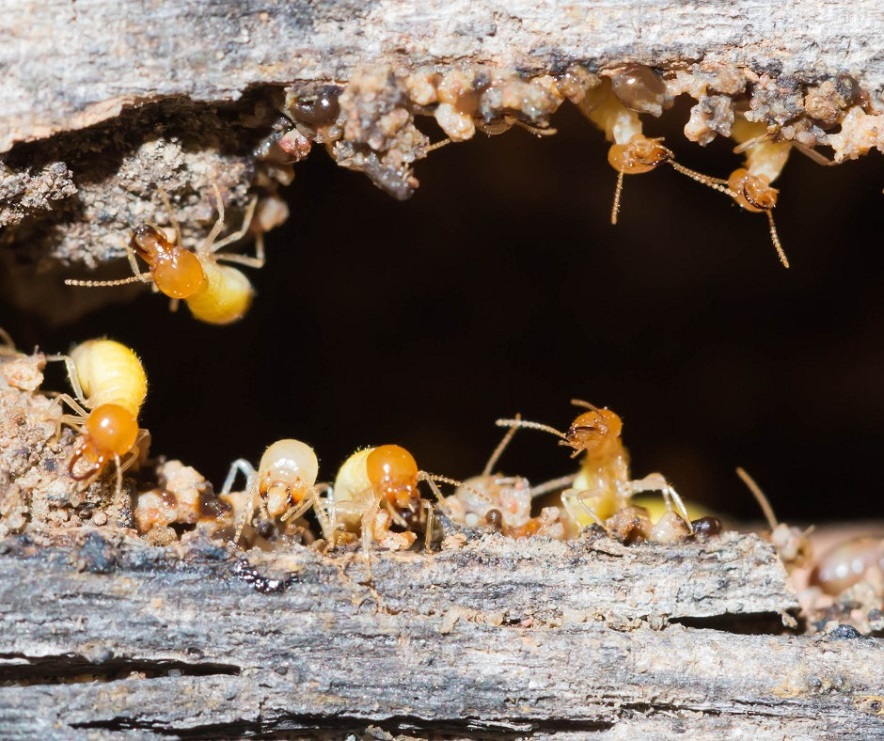
What to Look for in a Crawl Space Dehumidifier – You Get What You Pay For
Superior Filtration
When it comes to good indoor air quality in the home, it is crucial to filter the air below it before reaching the living space. Look for dehumidifiers equipped with MERV-13 filters. What does this mean? These units will remove 98% of dust compared to the MERV-8 filter, which only has 90% dust removal. Over six years, these premium filters can remove up to two pounds of dust, pollen, mold spores, and bacteria from the air in your crawl space.
Commercial Grade
Look for American-based manufacturers that offer dehumidifiers that utilize commercial components used in industrial, agricultural, and commercial applications. This ensures that you are getting a quality dehumidifier that can withstand low-temp operations and the corrosive environments of crawl spaces. Yes, no matter how well you encapsulate the crawl space, it is still a corrosive environment. Remember the pest chemicals?
Warranty
When you purchase a commercial-grade dehumidifier, you get a commercial-grade warranty. Most big-box units come with a one-to-two-year warranty, and before you know it, you have a graveyard of dehumidifiers. Look for a dehumidifier with a six-year warranty. Yes, you will pay more upfront, but you will save money, and the home and occupants will be protected in the long term.
Maximum Air Movement
A key factor to consider when choosing a dehumidifier is the amount of air movement needed to distribute dry air throughout the crawl space. Most free-standing dehumidifiers tend to recirculate the air immediately surrounding them, creating a zone of warm, lower-relative-humidity. This often leads to a dehumidifier short-cycling — not only is this inefficient, but it delivers poor moisture control throughout the space
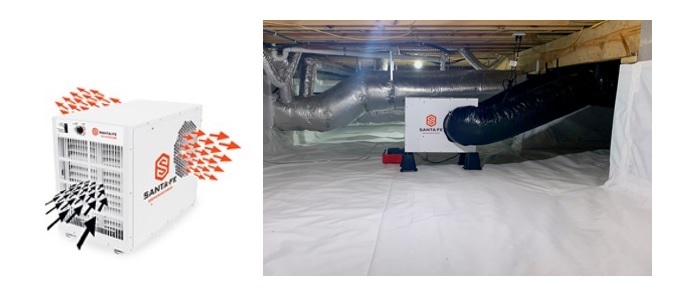
Dehumidifiers with dual exhaust provide the optimal amount of airflow in crawl spaces. The powerful dual exhaust improves air circulation throughout the entire space, allowing the maximum amount of air to be treated in the shortest time. Dual exhaust dehumidifiers will offer a lot of versatility for any application.
Energy Efficiency
Many big box dehumidifiers are not energy efficient at effectively removing moisture in low-temp environments. Look for commercial-grade dehumidifiers that exceed the Department of Energy requirements. These units are manufactured for performance, efficiency, and longevity.
In August of last year, the Consumer Product Safety Commission issued a recall on about two million dehumidifiers because they can overheat and catch fire, posing fire and burn hazards. If you have a big box portable dehumidifier, please follow this link to see if yours is part of the recall - https://www.cpsc.gov/Recalls/2021/Two-Million-Dehumidifiers-With-Well-Known-Brand-Names-Recalled-Due-to-Fire-and-Burn-Hazards-Manufactured-by-New-Widetech.
Conclusion
There are a lot of benefits in encapsulating crawl spaces, but it is important to remember that if proven building science principles are not understood and applied, it could create unwanted side effects. Ensure that you are consulting a properly trained professional who provides a warranty on their work. If you are a professional that is looking for training on how to encapsulate a crawl space properly, Santa Fe Indoor Air Quality Solutions teamed up with Jeremy Reets, a restoration industry expert and owner of Reets Drying Academy, to work with building science experts like Dr. Joe Lstriburek, Allison Bailes, Paul Hardy, Chris Conway, and Advanced Energy to develop the industry’s only two-day training course focused on the building science of encapsulating crawl spaces - Crawl Space Encapsulation Specialist. More information of the course can be found here - https://www.santa-fe-products.com/crawl-space-specialist-training/

